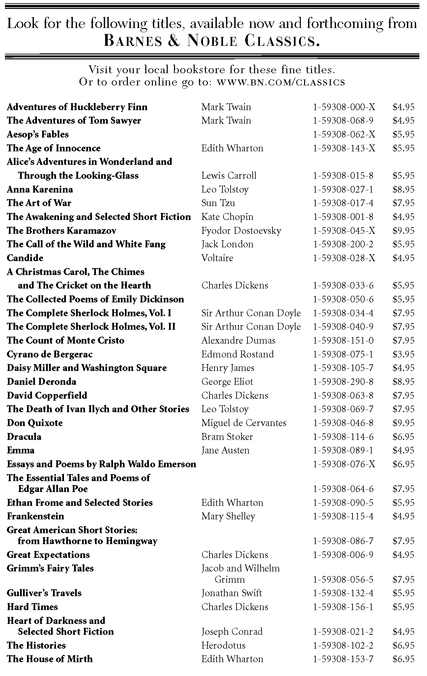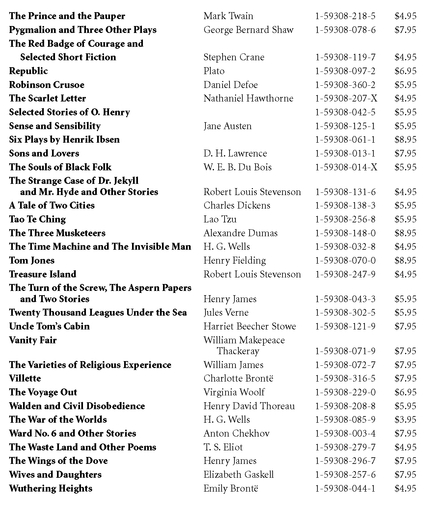Moby-Dick (Barnes & Noble Classics Series) (96 page)
Read Moby-Dick (Barnes & Noble Classics Series) Online
Authors: Herman Melville
Chase, Richard.
Herman Melville: A Critical Study.
New York, 1949. Still worth reading, particularly on the author’s use of folk humor.
Herman Melville: A Critical Study.
New York, 1949. Still worth reading, particularly on the author’s use of folk humor.
Matthiessen, F. O.
American Renaissance: Art and Expression in the Age of Emerson and Whitman.
London and New York: Oxford University Press, 1941. The classic study of our mid-nineteenth-century literature. Its arguments have been absorbed into later scholarship, but this book remains more readable than much that came after it.
American Renaissance: Art and Expression in the Age of Emerson and Whitman.
London and New York: Oxford University Press, 1941. The classic study of our mid-nineteenth-century literature. Its arguments have been absorbed into later scholarship, but this book remains more readable than much that came after it.
Philbrick, Nathaniel.
In the Heart of the Sea: The Tragedy of the Whaleship
Essex. New York: Viking Penguin, 2000. A fine and readable account of the shipwreck that was one of Melville’s important sources for
Moby-Dick
; informative on the culture of Nantucket; concentrates on the fates of the survivors, in this sense beginning where
Moby-Dick
stops.
In the Heart of the Sea: The Tragedy of the Whaleship
Essex. New York: Viking Penguin, 2000. A fine and readable account of the shipwreck that was one of Melville’s important sources for
Moby-Dick
; informative on the culture of Nantucket; concentrates on the fates of the survivors, in this sense beginning where
Moby-Dick
stops.
Vincent, Howard P.
The Trying-Out of
Moby-Dick. Boston, Houghton Mifflin, 1949. An important early study of Melville’s use of his sources.
The Trying-Out of
Moby-Dick. Boston, Houghton Mifflin, 1949. An important early study of Melville’s use of his sources.
TIMELESS WORKS. NEW SCHOLARSHIP. EXTRAORDINARY VALUE.




BARNES & NOBLE CLASSICS
If you are an educator and would like to receive an Examination or Desk Copy of a Barnes & Noble Classic edition, please refer to Academic Resources on our website at
WWW.BN.COM/CLASSICS
WWW.BN.COM/CLASSICS
or contact us at
All prices are subject to change.
a
The Roman statesman Cato the Younger (95-46 B.C.) killed himself rather than submit to Caesar.
b
Poseidon.
c
Not to eat beans.
d
With Sodom, a sinful city destroyed by God; see the Bible, Genesis 18-19.
e
Valley south of Jerusalem, symbolic of Hell.
f
Wind that shipwrecked Saint Paul; see the Bible, Acts 27.
g
Raised from the dead by Christ; see the Bible, John 11-12 and Luke 16:19-31.
h
Also called the Spice Islands; in the Malay Archipelago.
i
Prophet swallowed by a whale but saved by God; see the Bible, Jonah 1-2.
j
Usually
scrimshaw
; scenes drawn on or objects carved from whale teeth or bone.
‡
Southern tip of Manhattan in New York City.
scrimshaw
; scenes drawn on or objects carved from whale teeth or bone.
‡
Southern tip of Manhattan in New York City.
k
See Chap. XXIII, “The Lee Shore,” where Bulkington is made the symbol of unending physical and intellectual adventure.
l
Jacket.
m
In Greek myth, a complex structure built by Daedalus for King Minos to house the monster Minotaur.
n
Inhabitants of the Polynesian Islands.
o
Cotton fabric; the Indian city Bombay had become known for it.
p
Popular magician of the time.
q
Near Bombay, India, an island dedicated to worship of the Hindu god Shiva, spirit of destruction.
r
Dangerous shoals near the coast of England.
s
Military promotion without higher pay and with limited exercise of rank.
t
Canadian city; the upper city is on a bluff fortified in earlier warfare.
u
Castle sited high above the Rhine River.
v
Horatio Nelson, great British admiral killed on his ship
Victory
at the Battle of Trafalgar in 1805.
Victory
at the Battle of Trafalgar in 1805.
w
Important whaling port on Long Island, New York.
x
Peter the Great (1672-1725), Russian emperor; when young he traveled and worked abroad for experience.
y
Island south of Cape Cod, a great whaling port; at the time it had a significant population.
z
Stand to hold a wig.
aa
Skilled makers of wooden casks.
ab
Off the coast of England.
ac
Type of clam.
ad
Alexander the Great, conqueror of a vast empire in the fourth century B.C.
ae
Prussia, Russia, and Austria took over parts of Poland in partitions of 1772, 1793, and 1795, eventually completely eliminating it.
af
The hotel is named after the large iron kettles in which oil is rendered from blubber.
ag
In nautical language, right, the opposite of port, or
larboard
.
larboard
.
ah
Ninth month of the Islamic calendar, requiring daytime fasts.
ai
The creed of the Anglican Church.
aj
In Cologne Cathedral; supposedly relics of the wise men who bore gifts to infant Jesus.
ak
Thomas à Becket (1118-1170), killed by Henry II’s men over church policies.
al
Figure in Icelandic legend; his exploits are carved on his bedstead.
am
Chief of a Native American tribe.
an
He and Bildad, principal owners of
Pequod
, speak in Melville’s version of a Quaker dialect.
Pequod
, speak in Melville’s version of a Quaker dialect.
ao
The Categut is the North Sea between Jutland and Sweden; here descriptive of Bildad.
ap
The quotation is from the Bible (King James Version), Matthew 6:19-20.
aq
The quotation is from the Bible (KJV ), Matthew 6:21.
ar
Bottles for holding condiments.
as
Prophet who denounced King Ahab’s evil deeds; see the Bible, 1 Kings 16 and following chapters.
at
Sellers of foodstuffs.
au
Disreputable street in Liverpool described in Melville’s novel
Redburn
(1849).
Redburn
(1849).
av
Collection of hymns by Isaac Watts (1674-1748).
aw
Cask holding one-third of the larger
pipe
.
pipe
.
ax
This is the last we hear of Bulkington; on p. 41.
ay
English navigator James Cook (1728-1779) explored the South Pacific.
az
Russian navigator Adam Krusentern (1770-1846) explored the North Pacific.
ba
English navigator George Vancouver (1757-1798) explored the South Pacific and Pacific coast of North America.
bb
King of Wessex who lived from 849 to 899; also a scholar, he translated into Anglo-Saxon accounts of voyages made by the ninth-century Norse explorer Ohthere.
bc
English statesman who defended the interests of colonial America in a famous address in 1775.
bd
Author’s note: see subsequent chapters for something more on this head.
be
John Bunyan (1628-1688), Puritan preacher and author of the popular
Pilgrim’s Progress
(1678, 1684).
Pilgrim’s Progress
(1678, 1684).
bf
Miguel de Cervantes Saavedra (1547-1616), Spanish author of
Don Quixote
.
‡
Soldier and U.S. president from 1829 to 1837; born in the Carolina backwoods.
Don Quixote
.
‡
Soldier and U.S. president from 1829 to 1837; born in the Carolina backwoods.
bg
In the biblical book of Esther, a Persian king known for power and luxury.
bh
Late-eighteen century French revolutionary who called himself the Orator of Mankind.
bi
Benvenuto Cellini (1500-1571) sculpted Perseu, who in classical myth killed the Gorgon Medusa.
bj
Capital of Ecuador.
bk
Tic doulourex, a painful twitching of facial muscles.
bl
In Shakespeare’s
Romeo and Juliet
, act 1, scene 4, Mercutio remarks on Romeo’s dream and Queen Mab, who brings dreams that suit the dreamer.
Romeo and Juliet
, act 1, scene 4, Mercutio remarks on Romeo’s dream and Queen Mab, who brings dreams that suit the dreamer.
bm
Thought of as the center-point of London; royal announcements were made there.
bn
Carolus Lannaeus (1707-1778), great Swedish botanist who developed a system of classification of plants and animals.
bo
“Penis which enters the female, who gives milk from breasts; from the law of nature justly and deservedly” (Latin).
bp
Author’s note: I am aware that down to the present time, the fish styled Lamatins and Dugongs (Pig-fish and Sow-fish of the Coffins of Nantucket) are included by many naturalists among the whales. But as these pig-fish are a noisy, contemptible set, mostly lurking in the mouths of rivers, and feeding on wet hay, and especially as they do not spout, I deny their credentials as whales; and have presented them with their pasports to quit the Kingdom of Cetology.
bq
In the Bible, Isaiah 38:8, on the sun dial of Ahaz the sun’s shadow goes back ten degrees and reveals a divine message.
br
Son of Adam and Eve who killed his brother Abel; his forehead was marked as a warning that he should not be killed; see the Bible, Genesis 4:1-16.
bs
In Greek mythology, the souls of the most wicked people were sent, as punishment for their sins, to Tartarus, the underworld’s lowest level.
bt
Author’s note: Why this book of whales is not denominated the Quarto is very plain. Because, while the whales of this order, though smaller than those of the former order, nevertheless retain a proportionate likeness to them in figure, yet the bookbinder’s Quarto volume in its diminished form does not preserve the shape of the Folio volume, but the Octavo volume does.
bu
Substance obtained from hart (deer) antlers; formerly the chief source of ammonia, used for smelling salts.
Other books
Black Tide by Caroline Clough
Bayou Stix Series: Bayou Stix Limited Edition Box Set by Skye Turner
Dancing in the Dark by Maureen Lee
Without Feathers by Woody Allen
Killing Eva by Alex Blackmore
I May Be Wrong But I Doubt It by Charles Barkley
The Color of Joy by Julianne MacLean
Vector by Robin Cook
Even Zombie Killers Can Die by Holmes, John, Grey, Alexandra